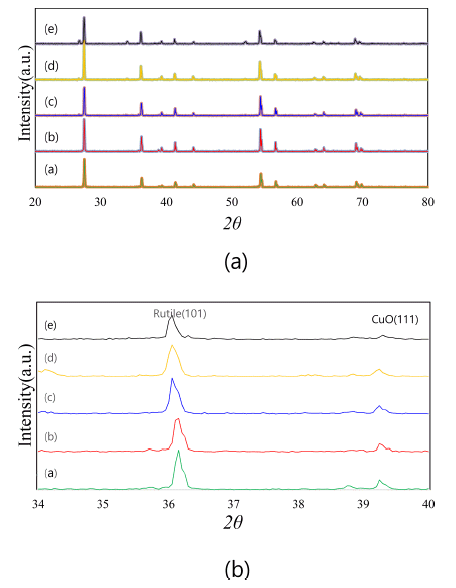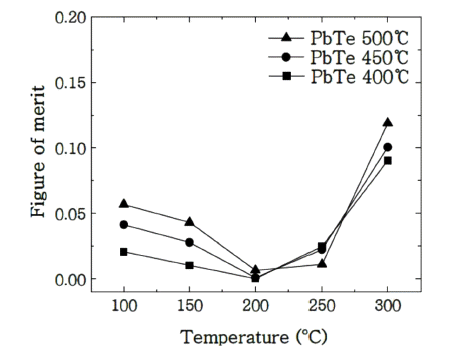Search
- Page Path
- HOME > Search
- [English]
- The Effect of TiO2 Addition on Low-temperature Sintering Behaviors in a SnO2-CoO-CuO System
- Jae-Sang Lee, Kyung-Sik Oh, Yeong-Kyeun Paek
- J Powder Mater. 2024;31(2):146-151. Published online April 30, 2024
- DOI: https://doi.org/10.4150/jpm.2024.00024

- 577 View
- 15 Download
-
 Abstract
Abstract
 PDF
PDF - Pure SnO2 has proven very difficult to densify. This poor densification can be useful for the fabrication of SnO2 with a porous microstructure, which is used in electronic devices such as gas sensors. Most electronic devices based on SnO2 have a porous microstructure, with a porosity of > 40%. In pure SnO2, a high sintering temperature of approximately 1300C is required to obtain > 40% porosity. In an attempt to reduce the required sintering temperature, the present study investigated the low-temperature sinterability of a current system. With the addition of TiO2, the compositions of the samples were Sn1-xTixO2-CoO(0.3wt%)-CuO(2wt%) in the range of x ≤ 0.04. Compared to the samples without added TiO2, densification was shown to be improved when the samples were sintered at 950C. The dominant mass transport mechanism appears to be grain-boundary diffusion during heat treatment at 950C.
- [English]
- The Effect of SnO2 Addition on Sintering Behaviors in a Titanium Oxide-Copper Oxide System
- Ju-Won Lee, Kyung-Sik Oh, Tai-Joo Chung, Yeong-Kyeun Paek
- J Powder Mater. 2022;29(5):357-362. Published online October 1, 2022
- DOI: https://doi.org/10.4150/KPMI.2022.29.5.357

- 333 View
- 3 Download
-
 Abstract
Abstract
 PDF
PDF The low-temperature sinterability of TiO2-CuO systems was investigated using a solid solution of SnO2. Sample powders were prepared through conventional ball milling of mixed raw powders. With the SnO2 content, the compositions of the samples were Ti1-xSnxO2-CuO(2 wt.%) in the range of x ≤ 0.08. Compared with the samples without SnO2 addition, the densification was enhanced when the samples were sintered at 900°C. The dominant mass transport mechanism seemed to be grain-boundary diffusion during heat treatment at 900°C, where active grain-boundary diffusion was responsible for the improved densification. The rapid grain growth featured by activated sintering was also obstructed with the addition of SnO2. This suggested that both CuO as an activator and SnO2 dopant synergistically reduced the sintering temperature of TiO2.
- [English]
- Effect of 50 μm class granules on the Injection Behavior of Brushite Bone Cement Prepared via Pre-dissolution Route
- Da Hye Mun, Sang Cheon Lee, Kyung-Sik Oh
- J Korean Powder Metall Inst. 2020;27(6):468-476. Published online December 1, 2020
- DOI: https://doi.org/10.4150/KPMI.2020.27.6.468

- 287 View
- 1 Download
-
 Abstract
Abstract
 PDF
PDF The bone cement used for vertebroplasty must be sufficiently injectable. The introduction of granules reduces the amount of liquid required for liquefaction, implying that higher fluidity is achieved with the same amount of liquid. By employing β-tricalcium phosphate granules with an average diameter of 50 μm, changes in injectability are observed based on the paste preparation route and granular fraction. To obtain acceptable injectability, phase separation must be suppressed during injection, and sufficient capillary pressure to combine powder and liquid must work evenly throughout the paste. To achieve this, the granules should be evenly distributed. Reduced injection rates are observed for dry mixing and excessive granular content, owing to phase separation. All these correspond to conditions under which the clustered granules weakened the capillary pressure. The injected ratio of the paste formed by wet mixing displayed an inverted U-type shift with the granular fraction. The mixture of granules and powder resulted in an increase in the solid volume fraction, and a decrease in the liquid limit. This resulted in the enhancement of the liquidity, owing to the added liquid. It is inferred that the addition of granules improves the injectability, provided that the capillary pressure in the paste is maintained.
- [Korean]
- Mechanical Properties and Thermal Stability of Ti0.5Al0.5N/CrN Nano-multilayered Coatings
- Seung-Su Ahn, Jong-Keuk Park, Kyung-Sik Oh, Tai-Joo Chung
- J Korean Powder Metall Inst. 2020;27(5):406-413. Published online October 1, 2020
- DOI: https://doi.org/10.4150/KPMI.2020.27.5.406

- 224 View
- 2 Download
-
 Abstract
Abstract
 PDF
PDF Ti0.5Al0.5N/CrN nano-multilayers, which are known to exhibit excellent wear resistances, were prepared using the unbalanced magnetron sputter for various periods of 2–7 nm. Ti0.5Al0.5N and CrN comprised a cubic structure in a single layer with different lattice parameters; however, Ti0.5Al0.5N/CrN exhibited a cubic structure with the same lattice parameters that formed the superlattice in the nano-multilayers. The Ti0.5Al0.5/CrN multilayer with a period of 5.0 nm exceeded the hardness of the Ti0.5Al0.5N/CrN single layer, attaining a value of 36 GPa. According to the low-angle X-ray diffraction, the Ti0.5Al0.5N/CrN multilayer maintained its as-coated structure up to 700°C and exhibited a hardness of 32 GPa. The thickness of the oxidation layer of the Ti0.5Al0.5N/CrN multilayered coating was less than 25% of that of the single layers. Thus, the Ti0.5Al0.5N/CrN multilayered coating was superior in terms of hardness and oxidation resistance as compared to its constituent single layers.
- [Korean]
- Thermoelectric Properties of PbTe Prepared by Spark Plasma Sintering of Nano Powders
- Eun-Young Jun, Ho-Young Kim, Cham Kim, Kyung-Sik Oh, Tai-Joo Chung
- J Korean Powder Metall Inst. 2018;25(5):384-389. Published online October 1, 2018
- DOI: https://doi.org/10.4150/KPMI.2018.25.5.384

- 384 View
- 5 Download
- 2 Citations
-
 Abstract
Abstract
 PDF
PDF Nanoparticles of PbTe are prepared via chemical reaction of the equimolar aqueous solutions of Pb(CH3COO)2 and Te at 120°C. The size of the obtained particles is 100 nm after calcination in a hydrogen atmosphere. Dense specimens for the thermoelectric characterization are produced by spark plasma sintering of prepared powders at 400°C to 500°C under 80 MPa for 5 min. The relative densities of the prepared specimens reach approximately 97% and are identified as cubic based on X-ray diffraction analyses. The thermoelectric properties are evaluated between 100°C and 300°C via electrical conductivity, Seebeck coefficient, and thermal conductivity. Compared with PbTe ingot, the reduction of the thermal conductivities by more than 30% is verified via phonon scattering at the grain boundaries, which thus contributes to the increase in the figure of merit.
-
Citations
Citations to this article as recorded by- Improved Thermoelectric Performance of Cu3Sb1−x−ySnxInySe4 Permingeatites Double-Doped with Sn and In
Ho-Jeong Kim, Il-Ho Kim
Korean Journal of Metals and Materials.2023; 61(6): 422. CrossRef - Enhancing Electrical Properties of N-type Bismuth Telluride Alloys through Graphene Oxide Incorporation in Extrusion 3D Printing
Jinhee Bae, Seungki Jo, Kyung Tae Kim
journal of Korean Powder Metallurgy Institute.2023; 30(4): 318. CrossRef
- Improved Thermoelectric Performance of Cu3Sb1−x−ySnxInySe4 Permingeatites Double-Doped with Sn and In
- [Korean]
- Microstructural Evolution and Properties in Ti(CN)-Co/Ni Cermet Depending on the Starting Material for Incorporation of WC
- Tai-Joo Chung, Sun-Yong Ahn, Seung-Su Ahn, Myung-Soo Shin, Hak-Kyu Kim, Kyung-Bae Kim, Kyung-Sik Oh, Hyuk-Jae Lee
- J Korean Powder Metall Inst. 2007;14(2):132-139.
- DOI: https://doi.org/10.4150/KPMI.2007.14.2.132

- 324 View
- 2 Download
- 1 Citations
-
 Abstract
Abstract
 PDF
PDF - In the Ti(CN)-Co/Ni cermet, WC is an effective additive for increasing sinterability and mechanical properties such as toughness and hardness. In this work, WC, (WTi)C and (WTi)(CN) were used as the source of WC and their effects were investigated in the respect of microstructural evolution and mechanical properties. Regardless of the kinds of WC sources, the hard phase with dark core and bright rim structure was observed in the Ti(CN)-Co/Ni cermet under the incorporation of relatively small amount of WC. However, hard phases with bright core began to appear and their frequency increased with the increase of all kinds of WC source addition. The ratio of bright core to dark one in the (TiW)(CN)-Co/Ni cermet was greatest under the incorporation of (WTi)C compared at the same equivalent amount of WC. The mechanical properties were improved with the addition of WC irrespective of the kinds of sources, but the addition of (WTi)(CN) was less effective for the increase of fracture toughness.
-
Citations
Citations to this article as recorded by- Investigation into the microstructure and cutting performance of (Ti,Ta,W)(CN)–Co/Ni cermets
Se-Woong Oh, Sun-Yong Ahn, Kyung-Sik Oh, Hyukjae Lee, Tai-Joo Chung
International Journal of Refractory Metals and Hard Materials.2015; 53: 36. CrossRef
- Investigation into the microstructure and cutting performance of (Ti,Ta,W)(CN)–Co/Ni cermets
- [Korean]
- Effect of Grain Size and Heat-treating Atmosphere on the Phase Stability of Y-TZP
- Tai-Joo Chung, Seung-Su Ahn, Eun-Wha Song, Kyung-Sik Oh, Jong-Sook Lee, Young-Sik Kim
- J Korean Powder Metall Inst. 2006;13(5):360-365.
- DOI: https://doi.org/10.4150/KPMI.2006.13.5.360

- 359 View
- 0 Download
- 1 Citations
-
 Abstract
Abstract
 PDF
PDF - The phase stability of tetragonal phase in Y-TZP was investigated in terms of the distribution of grain sizes and heat-treating atmosphere. Y-TZP with various grain sizes were prepared using duration time at 1600°C as experimental parameter. Accumulated grain size distributions were built from the SEM micrographs and the amount of tetragonal phase were measured using XRD. Both results were compared to determine the critical grain size before and after heat-treatment in vacuum. The critical grain size drastically decreased compared with the small increase of average grain size due to the autocatalytic effect which critically affects the tetragonal to monoclinic phase transformation. After heat-treatment in reductive atmosphere critical grain size relatively increased due to the stabilization of tetragonal phase. The formation of oxygen vacancies during heat-treatment was ascribed to the increase of stability.
-
Citations
Citations to this article as recorded by- Direct Observation on the Low Temperature Degradation Due to Surface Treatment in Y-TZP
Tai-Joo Chung, Hye-Sung Kim
Journal of Korean Powder Metallurgy Institute.2010; 17(3): 197. CrossRef
- Direct Observation on the Low Temperature Degradation Due to Surface Treatment in Y-TZP
- [English]
- Fabrication of Ag doped Hydroxyapatite and its Antimicrobial Effects with the Particle Size
- Kyung-Sik Oh, Kyung-Ja Kim, Young-Keun Jeong
- J Korean Powder Metall Inst. 2001;8(3):192-196.

- 96 View
- 0 Download
-
 Abstract
Abstract
 PDF
PDF - Ag doped Hydroxyapatite powder in nano-scale was successfully synthesized either by co-precipitation or by ion exchange route. The fabricated powder was successfully dispersed through freeze drying due to the prevention of secondary particles. The antimicrobial effects of nano-HAp against E.coli was superior to micron ones not only in its strength but also in duration.
TOP
 kpmi
kpmi


 First
First Prev
Prev


